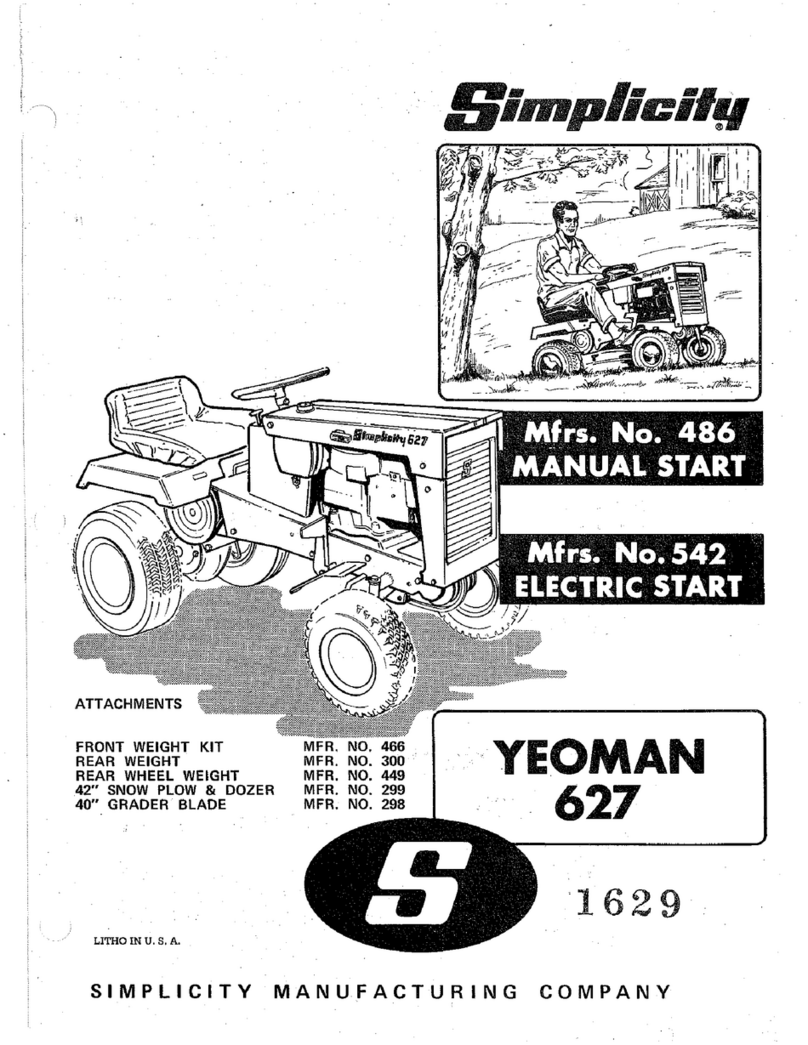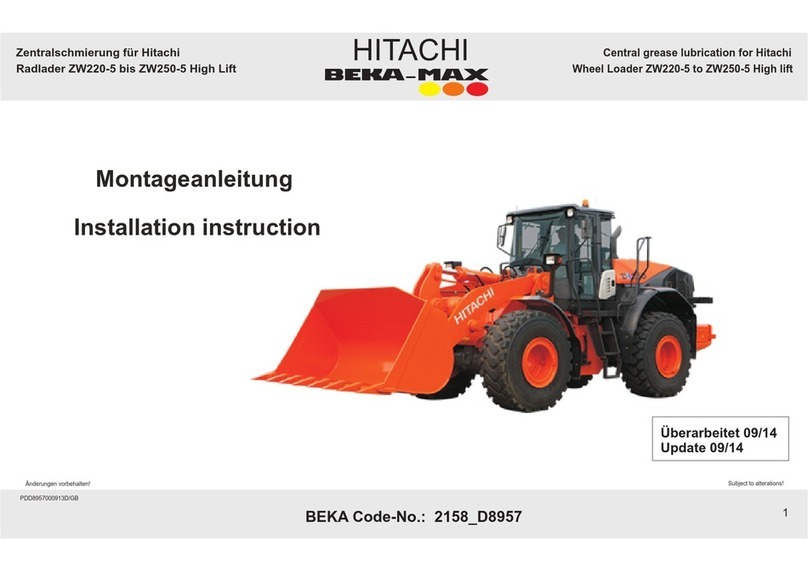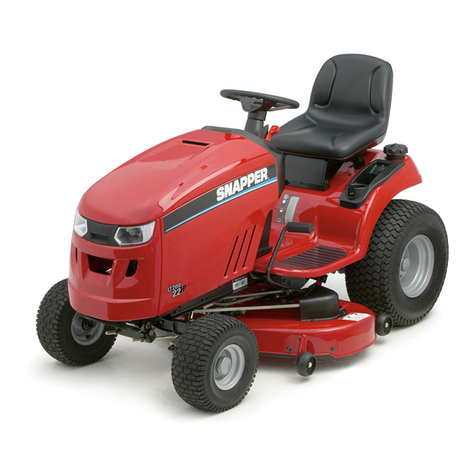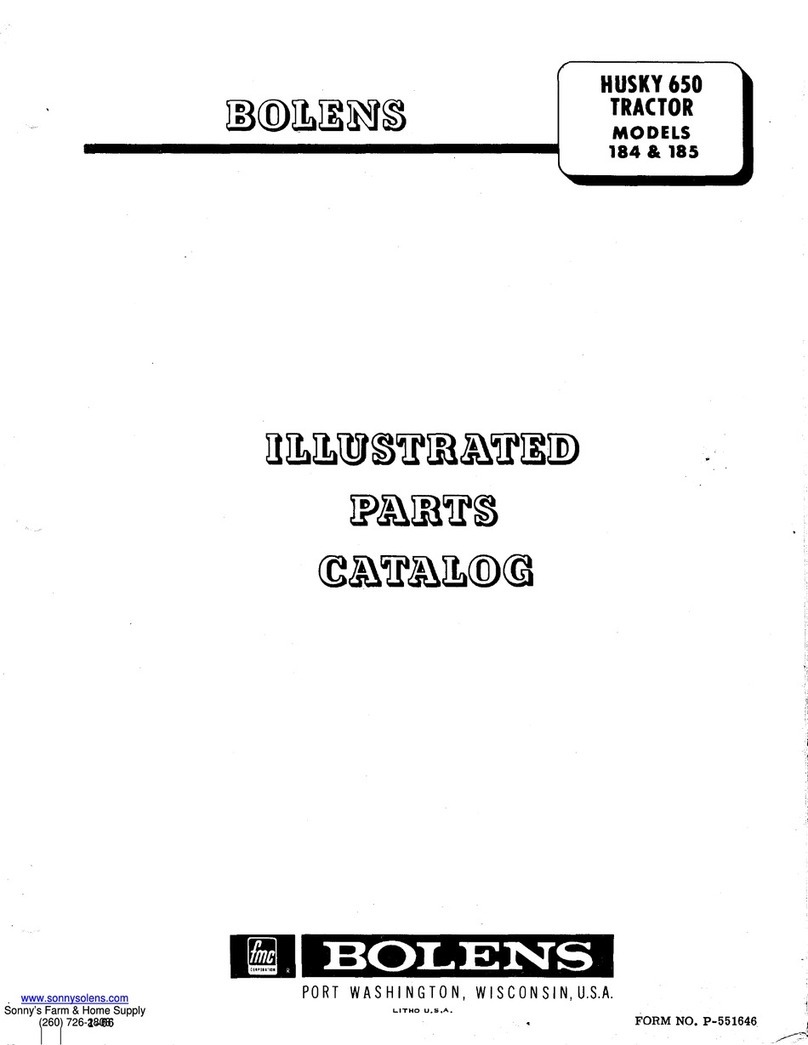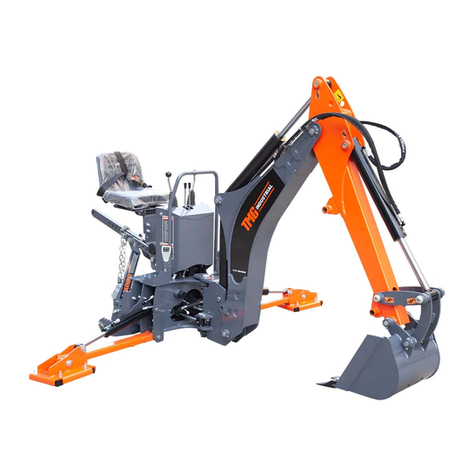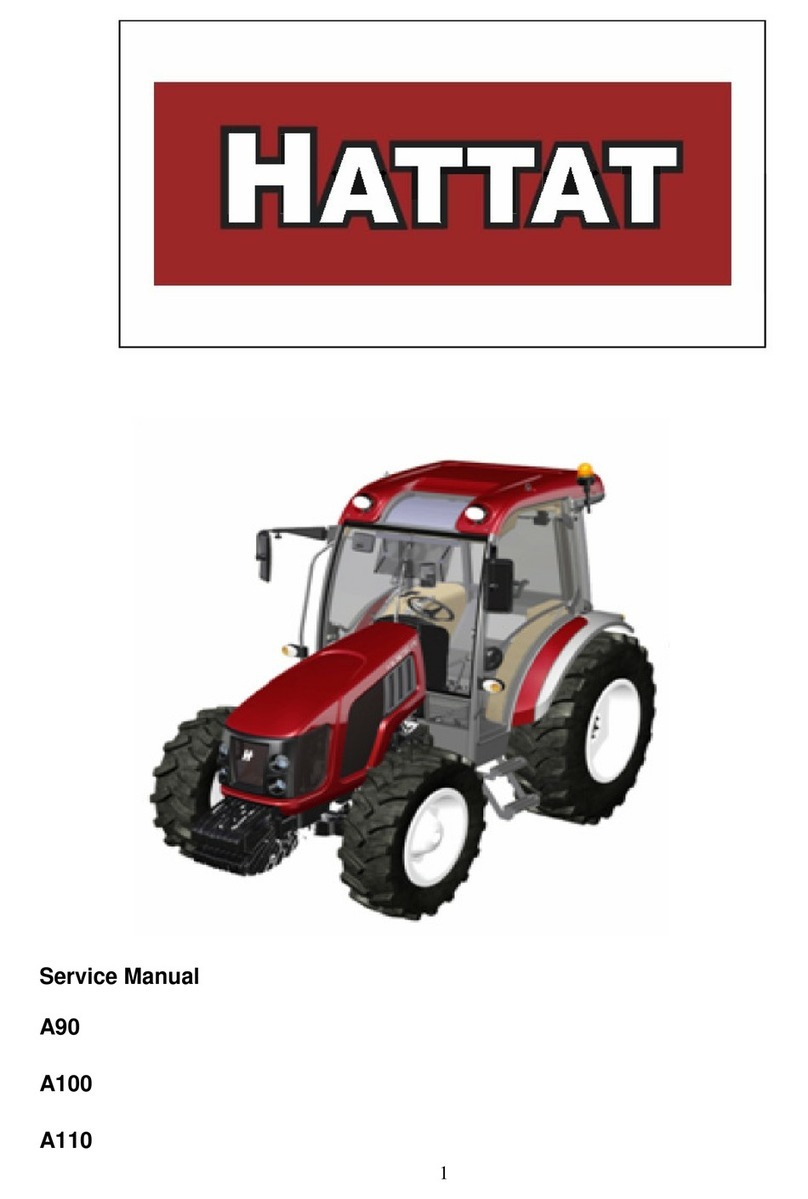EP Equipment QDD10L User manual

Pedestrian electric tow tractor Part No.
V1 04/2021
Operation Manual
QDD10L
508000004874

EP EQUIPMENT CO.,LTD. is one of the world’s
leading companies manufacture, design material
handling equipment and provide related service.
With over 100,000 square metres plant it produces
over 100,000 trucks per year, and provides
professional, effective and optimized material
handling solutions worldwide, until now it has
developed three major kinds of business:
Material handling equipment: Focus
on electric truck and warehouse
equipment
OEM parts: Global parts supply
Imow industry,online: One-stop
industrial products supply
Guided by our customer-oriented concept, EP
has developed service centers in more than 30
countries around the world, from which customers
are able to receive timely local service. Moreover,
95% of warranty parts can be shipped out within
24 hours after been ordered. Through our online
after-sales service system, customers can
process their warranty claims, order spare parts
and consult the operation manuals, maintenance
materials and spare parts catalogs.
With business all over the world, EP has
thousands of employees and hundreds of agents
worldwide to provide our global customers with
prompt local service.
Based on the concept of sharing economy, EP
also oer rental service for various logistics
equipment. Adhering to the idea “Making the
leasing of logistic equipment more simple”, EP
is devoted to providing customized one-stop
leasing solutions for our customers with our
high quality, reasonable price and prompt rental
service.
EP’s mission&vision is “ Let more people apply
the electrical material handling equipment to
relieve the intensity of labour” and “Let’s grow
together”.
•
•
•
Fig0000-00011OM
EP EQUIPMENT CO., LTD
Address: No.1 Xiaquan Village,
Lingfeng Street, Anji, Huzhou,
Zhejiang
Tel: + 86-0571-28023920
Website: www.ep-ep.com
Email: [email protected]

Foreword
The present operation manual is designed to provide sucient instructions for the safe operation of
the industrial truck. The information is provided clearly and concisely.
Our trucks are under ongoing development. EP reserves the right to alter the design, equipment
and technical features of the system. No guarantee of particular features of the truck should
therefore be assumed from the present operation manual.
Safety notices and text mark-ups
Safety instructions and important explanations are indicated by the following graphics:
Means that failure to comply can cause risk to life and/or major damage to property.
Please strictly adhere to these safety instructions to avoid personal injury or major damage to
equipment.
Please pay attention to the important safety instructions.
Pay attention to Instruction.
WARNING
CAUTION
DANGER
i
NOTE
Internet address and QR code of Parts
manual
By entering the address http://www.ep-care.com
in a web browser or by
scanning the QR code, Login after registration,
Select “Parts purchase"
function and input part number or model name to
nd the truck.
Note: After registration, please send
email to info@ ep-care.com to activate
your account
ALL RIGHTS RESERVED
2020.9 01st EDITION

Declaration
EP EQUIPMENT CO., LTD.
Address: No.1 Xiaquan Village, Lingfeng Street, Anji, Huzhou, Zhejiang
We declare that the
Industrial truck: according to this operation manual
Type: according to this operation manual
complies with the most recent version of Machinery Directive 2006/42/EC.
Personnel authorised to compile the technical documents:
See EC/EU Declaration of Conformity
EP EQUIPMENT CO., LTD.
EC/EU Declaration of Conformity
The manufacturer declares that this industrial truck complies with the EC Machinery Directive
and the provisions of other applicable EC/EU directives eective at the time of sale. This can be
veried by means of the EC/EU Declaration of Conformity and the relevant certication label on the
nameplate.
The industrial truck is supplied with the EC/EU Declaration of Conformity document. This
declaration proves that this truck complies with the requirements of the EC Machinery Directive.
Unauthorized modication or additional installation of equipment to the structure of the industrial
truck may aect its safety, and will therefore invalidate the EC/EU Declaration of Conformity.
The EC/EU Declaration of Conformity must be carefully conserved and kept ready to be presented
to the relevant authorities. If this industrial truck is sold, this declaration document must be handed
over to the new owner.
Legal requirements for marketing

A Introduction...........................................................................................................................A1
1.1 Intended use.......................................................................................................................A2
1.2 Improper use ......................................................................................................................A3
1.3 Tractor truck handover........................................................................................................A3
B Truck Description .................................................................................................................B1
1.1 Application ..........................................................................................................................B1
1.2 Truck assemblies................................................................................................................B2
1.2.1 Tiller.................................................................................................................................B3
1.2.2 Battery discharge indicator .............................................................................................B4
1.3 Identication points and data plates ...................................................................................B5
1.3.1Truck data plate................................................................................................................B6
1.4 Standard version specications..........................................................................................B7
1.4.1Performance data for standard trucks ..............................................................................B7
1.4.2 Dimensions....................................................................................................................B10
C Safety...................................................................................................................................C1
1.1 Safety guidelines ................................................................................................................C1
1.2 Battery safety......................................................................................................................C3
1.3 Stability ..............................................................................................................................C3
1.4 Related Safety Instruction and Standard(For CE) .............................................................C4
D Transport and Commissioning .............................................................................................D1
1.1Hosting ................................................................................................................................D1
1.2 Securing the truck during transport ....................................................................................D1
1.3 Commissioning...................................................................................................................D2
1.4 Break-in period precautions................................................................................................D2
1.5 Towing an unpowered truck................................................................................................D2
E Operation .............................................................................................................................E1
1.1 Safety regulations for the operation of pallet trucks ...........................................................E1
1.2 Check before start up .........................................................................................................E1
1.2.1 Drive directions ...............................................................................................................E2
1.2.2 Start up............................................................................................................................E2
1.2.3 Driving, steering, braking.................................................................................................E2
1.3 Driving with a trailer............................................................................................................E3
1.4 Parking the truck securely ..................................................................................................E5
1.5 Trailer mode........................................................................................................................E6
F Battery Maintenance & Charging .........................................................................................F1
1.1 Precaution ..........................................................................................................................F1
1.2 Charging the battery with internal charger..........................................................................F1
1.3 Battery type & dimension....................................................................................................F1
1.4 Battery removal and installation .........................................................................................F2
Table of contents
Pg.

G Pallet Truck Maintenance ....................................................................................................G1
1.1 Operational safety and environmental protection...............................................................G1
1.2 Maintenance safety regulations..........................................................................................G1
1.3 Servicing and inspection.....................................................................................................G2
1.3.1Maintenance checklist ......................................................................................................G3
1.4 Maintenance Instructions....................................................................................................G4
1.4.1Prepare the truck for maintenance and repairs ................................................................G4
1.4.2 Remove the cover ...........................................................................................................G4
1.4.3 Checking the fuses..........................................................................................................G4
1.4.4 Changing the tyres ..........................................................................................................G5
1.4.5 Recommissioning ............................................................................................................G5
1.5 Decommissioning the industrial truck.................................................................................G6
1.5.1 Prior to decommissioning ................................................................................................G6
1.5.2 Restoring the truck to operation after decommissioning .................................................G6
1.6 Safety checks to be performed at regular intervals and following any unusual incidents G7
1.7 Final decommissioning, disposal........................................................................................G7
1.8 Tire replacement.................................................................................................................G7
H Troubleshooting ...................................................................................................................H1
I Lithium-ion battery.................................................................................................................I1
1.1 Information on the conformity of lithium-ion batteries.........................................................I2
1.2 It is necessary to respect the following guidelines:.............................................................I2
1.3 Intended use.......................................................................................................................I3
1.4 Reasonably foreseeable misuse ........................................................................................I3
2.1 Accessories ........................................................................................................................I3
3.1 BMS (Battery Management System)..................................................................................I3
4.1 Safety and warning.............................................................................................................I4
5.1 Transportation.....................................................................................................................I5
5.2 Shipping faulty batteries .....................................................................................................I5
6.1 Instructions for disposal......................................................................................................I6
7.1 Charging.............................................................................................................................I6
8.1 Storage...............................................................................................................................I7
9.1 Common Problems and Solutions......................................................................................I7
Pg.

REV. 04/2021
1A
A Introduction
The truck described in the present operating instructions is an industrial truck designed for towing
trailer loads.
It must be used, operated and serviced in accordance with the present instructions. All other types
of use lie beyond the scope of application and can result in damage to personnel, the truck or
property. In particular, avoid overloading the truck with loads which are too heavy or placed on
one side. The data plate attached to the truck.The owner must ensure that any damaged and/or
illegible Rated drawbar pull label are replaced. The industrial truck must not be used in areas at
risk of re or explosion, or subject to corrosion or excessive dust.
Proprietor responsibilities: For the purposes of the present operator manual the “proprietor”
is dened as any natural or legal person who either uses the rack himself, or on whose behalf it
is used. In special cases (e.g. leasing or renting) the proprietor is considered the person who, in
accordance with existing contractual agreements between the owner and user of the industrial
truck, is charged with operational duties. The proprietor must ensure that the truck is used only
for the purpose it is intended for and that danger to life and limb of the user and third parties are
excluded. Furthermore, accident prevention regulations, safety regulations and operating,
servicing and repair guidelines must be followed. The owner must ensure that all users have read
and understood these operating instructions.
If this operation manual is not observed, the warranty becomes void. The same applies if
improper works are carried out on the device by the customers and/or third parties without
permission of our customer service.
Adding attachments: Adding or tting any attachments which will interfere with, or supplement,
the functions of the truck is permitted only after written approval by the manufacturer has been
obtained. If necessary, the approval of local authorities has to be obtained. Any approval obtained
from local authorities does not, however, make the approval by the manufacturer unnecessary.
Modication
Unauthorized modication to the truck can result in injury or death.
Can not remove, disable or modify any safeguards or other safety devices. These include any
alarms, lights, mirrors, overhead guards, and load backrest extensions. If present, an overhead
guard is intended to provide protection to the operator from falling objects, but cannot protect from
every possible.
Exception:Only in the event that the truck manufacturer is no longer in business and there is no
successor in the interest to the business, may the user arrange for a modication or alteration to a
powered industrial truck, provided, however, that the user

REV. 04/2021 2A
Safety devices and warning labels
The safety devices, warning signs and warning instructions in the present operating instructions
must be strictly observed.
Hazardous area: A hazardous area is dened as the area in which people are at risk
from the truck movement, the load handler (e.g. trailers) or the load itself. This also
includes areas which can be reached by falling loads or by the trailer veering.
Where there is danger to personnel, a warning must be sounded with sucient notice.
Give a warning signal with plenty of time for people to leave.
If unauthorized personnel are still within the hazardous area stop the truck immediately.
a) arranges for the modication or alteration to be designed, tested and
implemented by an engineer(s) expert in industrial trucks and their safety.
b)maintains a permanent record of the design, test(s) and implementation of the modication or
alteration.
c) approves and makes appropriate changes to the capacity plate(s), decals, tags and
instruction handbook.
d) affixes a permanent and readily visible label to the truck stating the manner in which the
truck has been modied or altered, together with the date of the modication or alteration and
the name and address of the organization that accomplished those tasks.
Intended use
The industrial truck is designed for transporting indicated in the dataplate.
Safety installations and switches may not be removed or rendered unusable. Specied settings
may only be changed with the approval of the manufacturer.
Only the areas approved by the operating company or its representative may be used for
transportation purposes. Loads may only be deposited or stored at the intended places.
Inclines used by industrial trucks shall not exceed the limits specied by the manufacturer
and must have an adequately rough surface.
Danger points on driving lanes or routes shall be secured or marked by the customary road
trac signs and by additional warning signs, if necessary.
Driving routes shall be suciently paved, level and free of objects. Drain channels and
railways crossings, etc., shall be levelled and, if necessary, covered with ramps in such a way
that they can be driven over without bumps as far as possible.
The EU Directive 89/654/EEC (Minimum Regulations for Health and Safety for the workplace)
shall be observed. The respective national regulations apply for non-EU countries.
1.1
•
•
•
•
•
•

REV. 04/2021
3A
Improper use
The operating company or driver, and not the manufacturer, is liable if the truck is used in a
manner that is not permitted. The following list is exemplary and is not intended to be
exhaustive.
1.2
Do not turn when driving on a ramp.
Never park the truck in a place that may obstruct re extinguishers, re escapes or aisles.
Do not leave the truck unattended.
Do not stand on the hook device.
Do not increase the Rated drawbar pull.
Use the truck for loading / unloading on slopes
•
•
•
•
•
•
Danger points on driving lanes or routes shall be secured or marked by the customary road
trac signs and by additional warning signs, if necessary.
Driving routes shall be suciently paved, level and free of objects. Drain channels and
railways crossings, etc., shall be levelled and, if necessary, covered with ramps in such a way
that they can be driven over without bumps as far as possible.
The EU Directive 89/654/EEC (Minimum Regulations for Health and Safety for the workplace)
shall be observed. The respective national regulations apply for non-EU countries.
When driving on public roads, the corresponding regulations must be observed, as well as
country-specic restrictions for winter road conditions.
The operating company is responsible for adequate re protection in the vicinity of the
industrial truck.
Industrial trucks may only be used to tow trailers if they are intended for this purpose by the
manufacturer . The maximum towed load specied in the operating instructions for unbraked
or braked trailers must not be exceeded. The towing industrial truck must be operated in such
away that safe driving and braking of the towed vehicle is ensured for all driving movements.
•
•
•
•
•
To avoid the inconvenience of making a claim after use, check the Tractor truck is in perfect
condition and repair, and conrm your satisfaction with the vehicle on the manufacturer's
product qualication certicate upon handover.
Tractor truck handover1.3

REV. 04/2021
1
B
B Truck Description
Application
The truck is a rear drive, industrial electric tow-truck designed to tow tiller operated trailer
loads.
Ambient temperature: during operation: -10°C to 40°C.
Only use the truck at altitudes not exceeding 2000 meters.
The truck is not authorized for use on public highways.
The tractor is not authorised for use in cold stores .
The tractor is not authorised for use in the rain or water.
Trucks can only be operated in adequately illuminated working areas to avoid injuries. In case
of insucient light, an additional lighting equipment is needed to ensure that the driver can see
properly.
If you must travel on an incline, the gradients should be below A% at full load, or below B%
without a load.(For the value of A and B, refer to the Gradability in Performance Data Sheet)
1.1
•
•
•
•
•
•
•
•
•
•
WARNING
Extreme conditions
Special equipment and authorisation are required if the truck is to be constantly used in
extreme conditions, especially in dusty or corrosive atmospheres.
The truck is not authorised for use in areas at risk of explosion.
In adverse weather conditions (thunder, lightning) the industrial truck must not be operated
outside or in endangered areas.
i
NOTE
The truck may only be operated in cold stores temporarily as the permissible battery
operating temperature is between 0°C and 40°C . If the truck remains in a cold store, we
recommend with special measures for the truck or buy cold sore truck.

REV. 04/2021 2B
1 Driving Unit 8 Handwheel
2 Hook device 9 Tiller
3 Battery 10 charger plug
4 Cover 11 Key switch
5 LED lamp 12 Load wheels
6 Battery discharge indicator 13 Drive wheels
7 Emergency stop switch
1.2 Truck assemblies

REV. 04/2021
3
B
1.2.1 Tiller
14 Drive switch Controls travel direction and speed
15 Horn button Send out sound warning signals
16 Emergency reverse swith Through touching the button, truck drives
away from operator.
1.Key switch
Connect and interrupt control current.
When the key rotates to gear “OFF”, the control
current of the truck will be interrupted;
When the key rotates to gear “ON”, the control
current of the truck will be connected.
Fig0000-00070OM

REV. 04/2021 4B
1.2.2 Battery discharge indicator
• The LED (4) shows the total operation time
of the truck, if the truck failure, it will show
controller error.
• The LED (5) shows the remaining capacity.
When the truck start up, it will show a startup
display interface;
After the truck starting , it will display another
display interface;
i
Truck failure is in the service manual
controller error message section.
NOTE
4
5
3
1
2
• The LED (1) show the No Serialnumber. It
indicates the circular meter has no bluetooth
function.
• The LED (2) show the DIS3. It indicates the
version of the product.
• The LED (3) show the 007H. It indicates the
version of software.

REV. 04/2021
5
B
Identication points and data plates1.3
Anti-pinch hand label Instructions label
Do not rest on the pallet label Sling label
Rated drawbar pull label

REV. 04/2021 6B
Truck data plate
For queries regarding the truck or ordering spare parts please quote the truck serial number.
Item Description Item Description
1 PRODUCT NAME 8 UNLADEN MASS
2MODEL TYPE 9UNLANDEN MASS WITHOUT
BATTERY
3 MANUFACTURE DATE 10 SERIAL NO.
4 RATED DRAWBAR PULL 11 RATED CAPACITY
5 MAX DRAWBAR PULL 12 MAX BATTEY WEIGHT
6 RATED DRIVE POWER 13 MIN BATTERY WEIGHT
7 BATTERY VLOTAGE
1.3.1
1
2
3
4
5
6
7
8
9
10
11
12
13
For queries regarding the tractor or ordering spare parts please quote the tractor serial
number(10).

REV. 04/2021
7
B
Standard version specications
Technical specication details in accordance with VDI 2198. Technical modications and
additions reserved.
Performance data for standard trucks
1.4
1.4.1
Distinguishing mark
1.1 Manufacturer /
1.2 Model designation QDD10L
1.3 Drive unit Battery
1.4 Operator type Pedestrian
1.5 rated capacity Q kg 1000
1.7 Rated drawbar pull F N 200
1.9 Wheelbase y mm 320
Weight
2.1 Service weight (include battery) kg 120
2.2 Axle loading, laden driving side/
loading side
kg 120/0
2.3 Axle loading, unladen driving side/
loading side
kg 95/25
Types,Chassis
3.1 "Tyre type driving wheels/loading
wheels"
rubber

REV. 04/2021 8B
3.2 Tyre size, driving
wheels(diameter×width)
mm 2x Ф250x85
3.3 Tyre size, loading
wheels(diameter×width)
mm 2x Ф75x32
3.5 Wheels, number driving,
caster/loading (x=drive
wheels)
mm 2x /2
3.6 Track width, front,driving
side
b10 mm 428
3.7 Track width,rear,loading
side
b11 mm 217
Dimensions
4.8 Height, mast extended h7 (mm) mm
4.9 Height drawbar in driving
position min./max.
h14
(mm)
mm 965x1040x1130
4.12 Height of wheel arms h10(mm)
4.19 Overall length l1 (mm) mm 1200x1260x1290
4.21 Overall width b1/ b2 mm 520
4.32 Ground clearance, center
of wheelbase
m2 mm /
Performance data
5.1 Travel speed, laden/
unladen
km/ h km/
h
4.5/5
5.2 Lifting speed, laden/
unladen
m/ s 200
5.3 Lowering speed, laden/
unladen
m/ s 650
5.8 Max. gradeability, laden/
unladen
% 3/16
5.10 Service brake type Mechanical

REV. 04/2021
9
B
Electric-engine
6.1 Drive motor rating S2 60 min hp kW 0.4
6.3 The maximum allowed size
battery
in. mm 193/81/300
6.4 Battery voltage/nominal
capacity K5
V/ Ah 24/20
6.5 Battery weight lb. kg 5.8
Addition data
8.1 Type of drive control DC
10.5 Steering type Mechanical
10.7 Sound pressure level at the
driver’s ear
dB (A) 74

REV. 04/2021 10B
1.4.2 Dimensions

REV. 04/2021
1C
C Safety
Safety guidelines
The operating company must ensure that the driver understands all the safety information.
Observe the relevant regulations and guidelines,
e.g:
• Operation of industrial trucks
• Driving licences
• Rules for driveways and the area of operation
• Driver rights, duties and rules of behaviour
• Special operating areas
• Information regarding setting o, driving
and braking
• Information for maintenance and repair
• Periodic checks
• Disposal of greases, oils and battery
• Residual risks
1.1
Only trained and authorized operator shall be permitted to operate the truck.
Comply with trac rules.
Keep enough safe distance.
Inspect the truck at periodic intervals for oil or water leak, deformation, lousiness, etc. If
neglected, short life of components will be caused and in the worst case a fatal accident
would occur .
Make sure to replace the “key component” in schedule maintenance.
Wipe o oil, grease or water from the oor board and foot and hand controls. if any.
Check the battery with no-smoking or any sparks, ame near batteries.
Check motors, controllers, attention should not be scalded.
The controller has the accumulator, do not contact between B+ and B-, prevent of electrical
injury. If you want check or clean the controller, connect load between B+ and B-(such as
contactor coil or horn) to short the capacitor, and discharge the energy.
Electrical appliances, controllers, motor should prevent of washing by water or showing.
Whenever in trouble, you must stop the truck, hang a mark of “danger” or “trouble” and take
o the key, at the same time inform the manager .
If any trouble comes on at Load wheels or drive wheels. Please stop the truck and service
the truck at once, and let the truck in a safety place.
Operators should wear a crash helmet, working boot and working clothes. After charging,
clean the truck carefully. Don’t let any tools close the two terminal of the battery to avoid
spark or short circuit.
Make sure to operate the truck on concrete rmly enough or bituminous macadam. Check
the situation early in the work space.
Clean the work space, remove all obstacles, wipe out the macadam, mud, waste oil, and
water.
•
•
•
•
•
•
•
•
•
•
•
•
•
•
Table of contents
Popular Tractor manuals by other brands

Troy-Bilt
Troy-Bilt ST 110 1984 Service and repair manual

Case
Case FARMALL 80N Tier 4A Service manual

Priceless Aviation Products
Priceless Aviation Products 747B Technical manual and parts list

Case IH
Case IH JX Series Service manual
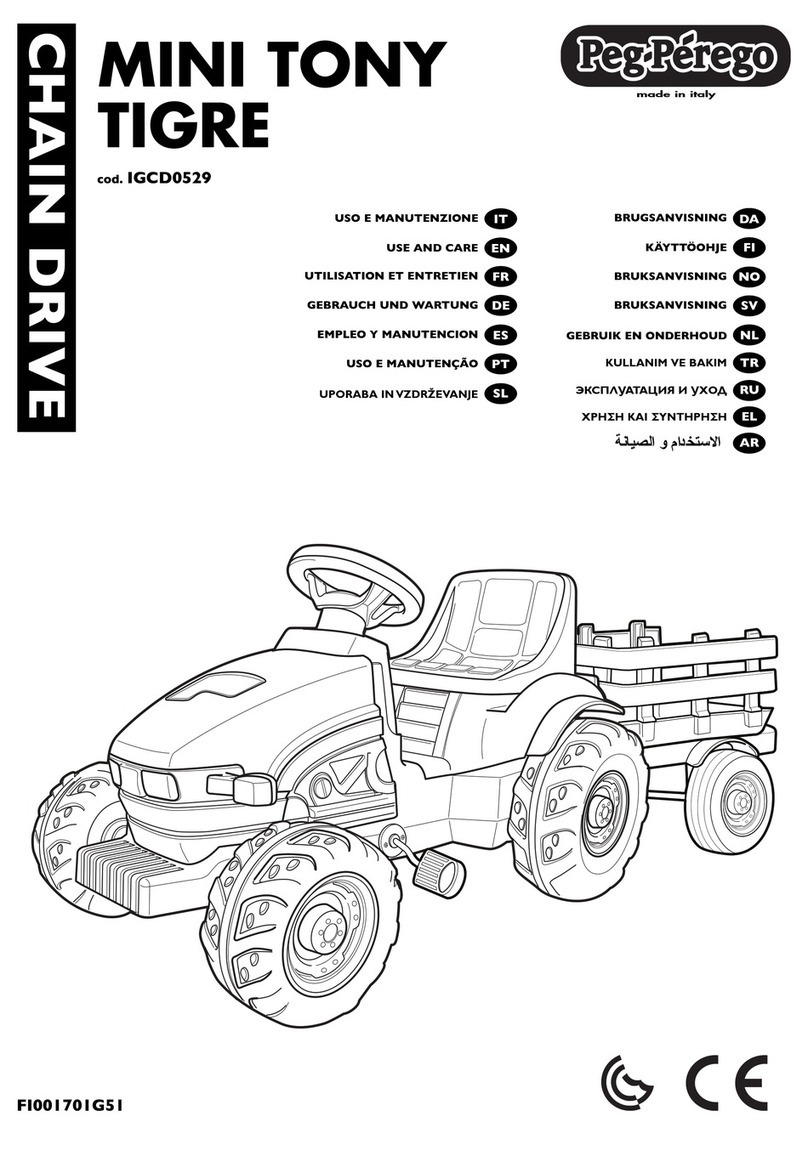
Peg-Perego
Peg-Perego MINI TONY TIGRE Use and care

Case IH
Case IH MAXXUM 115 Service manual
